ABSTRACT
This article aims to discuss the area, production, consumption, export and import, encountered problems, and policy support to one of Indonesia's important crops-garlic. It is quite interesting since the country depends on (above 90%) of imported garlic, particularly since the economic crisis in 1998. The government of Indonesia has issued certain regulations such as Import Recommendation for Horticulture Products (RIPH) and Import Permit Letter (SPI) as well as self-sufficiency for garlic. However, the dependence of the country on imported garlic remains still high. Garlic production was not competitive, while consumers preferred the imported garlic due to its lower price compared to the domestic garlic. Therefore, it is recommended to implement an economic incentive-based-output price subsidy, especially for garlic growers facing the lower price of imported garlic. This should be followed by implementing the development program at selected accessible potential central producing areas, empowering farmers through educational training of garlic farms and marketing, particularly for the young potential generation, and introducing technological package based on precision agriculture through smart farming practices to manage garlic production with a new method supported by constructive policy regulations related to investment opportunities. In the policy review session, this study presents a comprehensive review of the new import regulation. Through the Ministry of Agriculture and the Ministry of Trade, the central government seeks to reduce dependence on imported garlic and increase the quality and quantity of national garlic production for the central government's goal of being self-sufficient in garlic in 2024.
Keywords: garlic, production, consumption, import, development, policy, Indonesia
INTRODUCTION
Garlic (Allium sativum) is used widely as a flavoring in cooking, but it has also been used as a medicine throughout ancient and modern history. It has been taken to prevent and treat many conditions and diseases (Newman, 2017). In the case of Indonesia, the demand for garlic tends to increase overtime along with the increase in population and consumption, especially as a food ingredient.
Garlic is one of the strategic horticultural commodities in Indonesia; however, the country still depends on imports which tend to increase overtime, namely above 90% annually (BPS, 2020). Hence, this article discusses how government policy can support the development of garlic. It initially discusses domestic garlic performance in terms of harvested area, production, and consumption, followed by garlic export and import perspectives, encountered problems, policy support, and finally, the conclusion and recommendation.
In 2020, the Ministry of Agriculture noted that the national demand for garlic was 561,000 tons. However, domestic garlic production was only 88,000 tons. Due to the imbalance between national production and demand, Indonesia's garlic commodity is vulnerable to price fluctuations. The central government, in particular the Ministry of Agriculture has speculated to support the development of domestic garlic production. Referring to the Regulation of the Minister of Agriculture number 38 of 2017 concerning the Recommendation for the Import of Horticultural Products (RIPH), it is stated that imports must be integrated with the development of domestic commodities. Furthermore, the Minister of Agriculture stipulates that business actors in the garlic importing industry are obliged to plant and develop garlic domestically.
Responding to the central government's action plan to increase garlic's national production, the Ministry of Agriculture is targeting self-sufficiency in garlic by 2024 by aggressively encouraging the achievement of garlic self-sufficiency in the sub-national regions both in Java and outside Java. One region is a center for garlic production in Central Java, the second-largest producer in Indonesia after East Nusa Tenggara.
In achieving garlic self-sufficiency in 2024, this paper presents the latest data on the development of garlic in Indonesia today. This study provides a big picture of the production area, consumption, export, and import, encountered domestic problems, and new policy support on Indonesia's garlic development. In the policy review session, this study presents a comprehensive review of the new import regulation. Through the Ministry of Agriculture and the Ministry of Trade, the government seeks to reduce dependence on imported garlic and increase the quality and quantity of national garlic production for the central government's goal of food self-sufficiency
DOMESTIC GARLIC OF INDONESIA
Garlic can grow at various attitude areas, either upland or lowland depending on the variety used. The best planting area of garlic is at an altitude of 600-700 meters above sea level. Upland garlic variety would not be good if it were planted in the lowland, vice versa. The technical requirements for garlic crops are cold and dry conditions, especially during the bulb formation phase (Sandrakirana et al., 2018).
The central producing areas of garlic in Indonesia are North Sumatra, West Java, Central Java, Bali, West Nusa Tenggara (NTB), and East Nusa Tenggara (NTT) provinces (Figure 1). Certain garlic cultivars have been released as superior national varieties in the country, namely local Lumbu Putih, Lumbu Kuning, Lumbu Hijau, Tawamangu Biru, and Sangga Sembalun (Table 1). Besides these varieties, there are some potential local varieties for further development, including Kayu, Layur, Saigon, and Krisik.

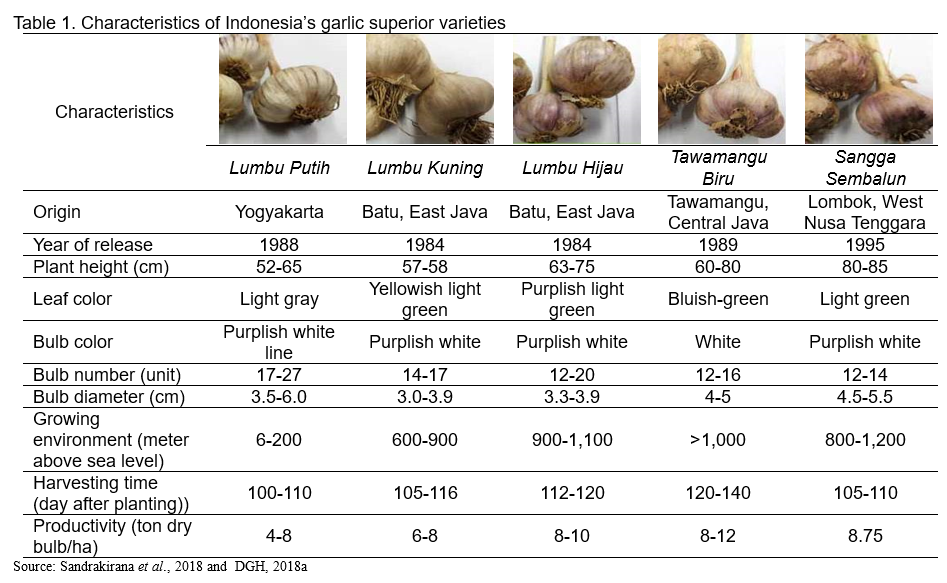
In general, the best time for planting garlic is from May to July. Nevertheless, it also depends on specific weather conditions in certain locations. As an illustration, Table 2 presents the planting seasons of garlic in Central Java, East Java, and West Nusa Tenggara.

Harvested area
In the last five years, the harvested area of garlic in Indonesia was aggregately increased about 68% from 2,407 hectares in 2016 to 12,801 hectares in 2020. The significant increase was started in 2019 (Figure 2). The sharp increase in harvest and production was supported by the Special Effort Program of the Ministry of Agriculture (DGH, 2019). In 2016, there were six locations with a total area of 1,900 hectares of garlic throughout Indonesia. Under the first implementation of this program in 2017, garlic was planted in 78 locations with an area of more than 5,400 hectares. Thus, the area of garlic becomes more than 7,000 hectares, or increased by 184.21% (DGH, 2019).
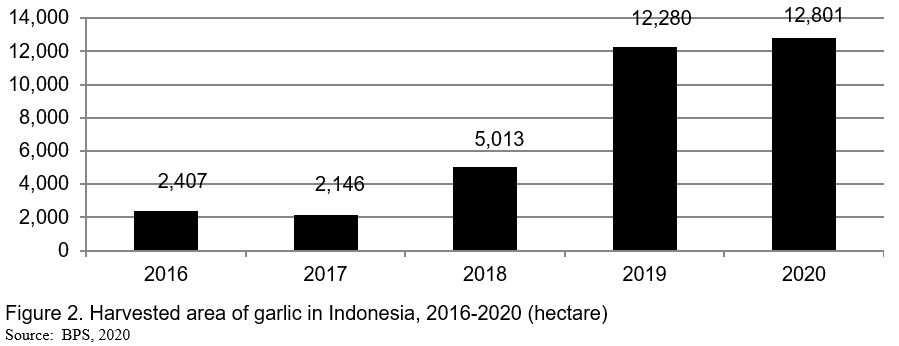
Garlic production
In line with the performance of the harvested area, the production of garlic tends to increase as well, particularly since 2018. Figure 3 shows that from 2016 to 2020, Indonesia’s garlic production was significantly increased by about 53% a year. During these periods, the average productivity of garlic was recorded at 7.87 tons per hectare.
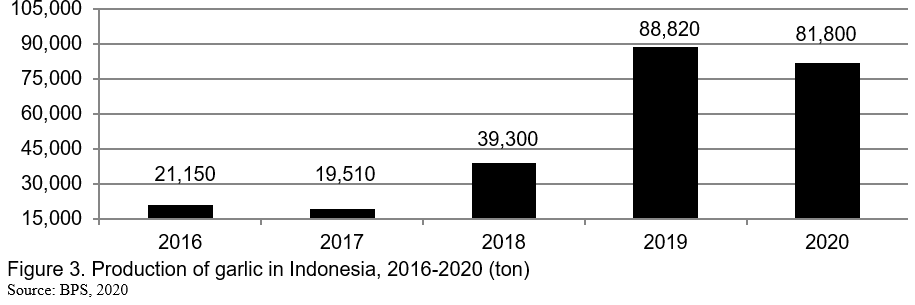
Table 3 shows the production of garlic in certain central producing areas, namely 37,815 tons per year. In aggregate, it reveals that the growth of garlic production improved about 56% from 2016 to 2020. The significantly increase in garlic production’s growth arose in 2018.
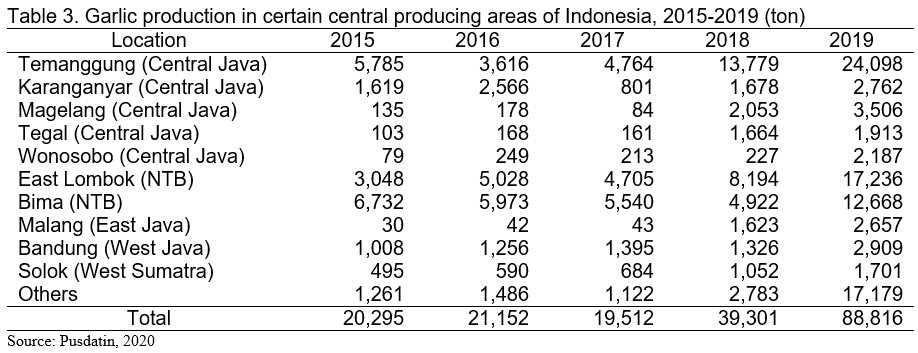
Consumption of garlic
The consumption of garlic was an average of 545,839 tons annually. The extent of garlic consumption slightly increased about 3.82% per year, namely 500,032 tons in 2016 to 561,686 tons in 2020 (Figure 4).
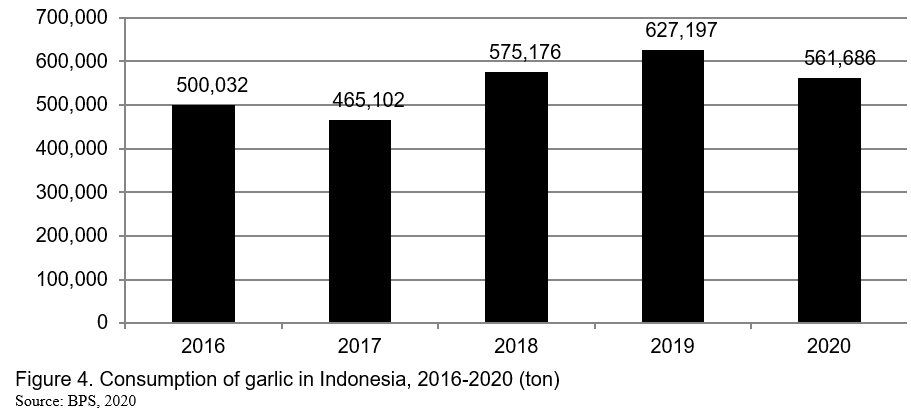
EXPORT AND IMPORT OF GARLIC
Export
The volume of garlic export from Indonesia was quite minor, namely about 186 tons per year. Likewise, the export value was only US$300,200 annually. During the last five years (2016-2020), the extent of volume and value of garlic export from Indonesia was fluctuating (Table 4). This was in line with the performance of domestic garlic production in the country.

Import
The garlic production was 37,815 tons per year, or 6.93% of the consumption (545,839 tons, annually). Therefore, Indonesia much depends on garlic import for fulfilling the state domestic consumption and other purposes (seeds, etc.), namely 530,314 tons (93.24%) per year (Table 5). Indonesia spends about US$539.36 million per year importing garlic. From 2016 to 2020, the growth of garlic import was 8.77% annually. The main country origin of imported garlic was China (99.36%).

Indonesia was ranked first among the big ten importer countries of garlic for consumption in the world. In 2020, the volume of garlic imports of Indonesia was 587,748 tons (Table 6). This was about 22% of the total world’s imports (2,705,924 tons) or 45% of the big ten importer countries.
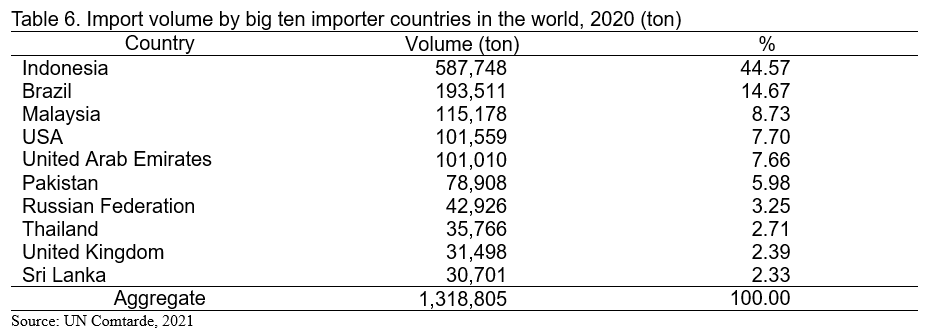
Figure 5 reveals that half of the imported garlic of ASEAN countries was carried out by Indonesia. It was followed by Vietnam, Malaysia, the Philippines, Thailand, and other countries (Singapore, Brunei Darussalam, Cambodia, and Lao PDR).
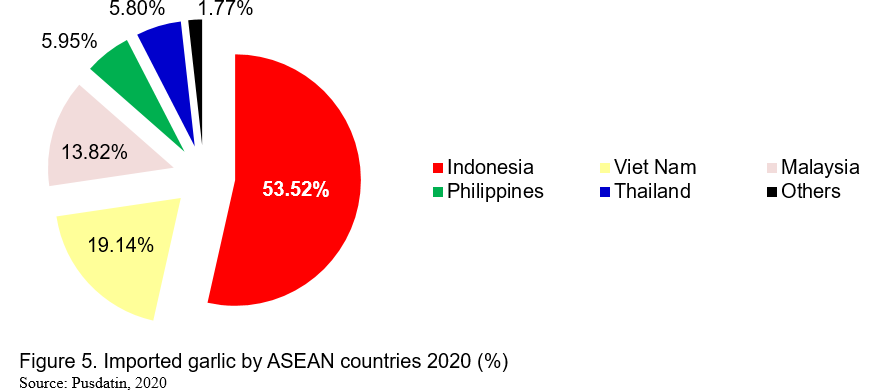
ENCOUNTERED PROBLEMS OF INDONESIA’S GARLIC
At least there are two technical and non-technical challenges of garlic development in Indonesia. Technically, garlic can grow in all over the county; however, the suitable areas for this plant are found in certain locations supported by specific environmental agro-ecosystem conditions. The most preferred degree of soil acidity (pH) is 6.5-7.5, whereas the soil must be limed if the pH is lower than 6.5. Garlic can grow well in an environment with a daily temperature from 15 to 20 0C, rainfalls between 100 and 200 millimeters per month, and sufficient sun intensity and air humidity between 60% and 80% (Sandrakirana et al., 2018). Hence, garlic farms should be considered to climate change phenomenon. In addition, garlic farmers should also alter conventional technology to modern ones.
Apart from environmental conditions, the accomplishment of the garlic farm much depends on the seeds' performance. The minimum requirements for seeds are as follows: (1) Uniform size; (2) Free of pests and diseases; (3) Guaranteed variety purity; and (4) Has passed the dormancy period. Thus, good quality of seeds is essential to which it requires specific cost in garlic farms. The share of operational garlic farm costs can be seen in Figure 6. It reveals that the share of seed cost is about 33% of the total cost of garlic farms.

In terms of socioeconomic aspect, due to the great extent of imported garlic, many farmers in Indonesia have to be prudent to grow garlic facing the economic competitiveness. As a comparison, the price of imported garlic was much lower than those of producer and consumer prices (Figure 7). According to Sandrakirana et al. (2018), about 95% of garlic consumed by Indonesians was imported from China due to the lower price and large size of its bulb. The lower price of garlic from China was due to the higher productivity (25.3 tons/ha) than that of Indonesia's garlic (8.7 tons/ha).
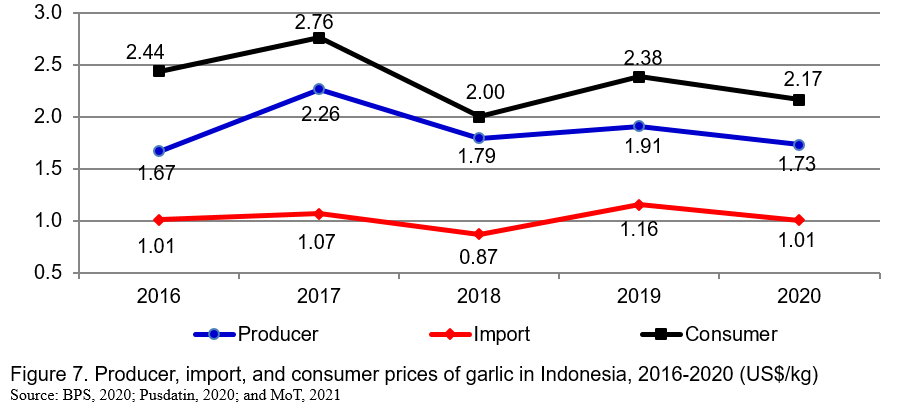
NEW POLICY SUPPORT FOR GARLIC DEVELOPMENT
Due to its high dependence on imported garlic, the Ministry of Trade revises the regulation on horticultural products. The Minister of Trade Regulation Number 27 of 2020 is an amendment to the earlier Regulation of the Minister of Trade Number 44 of 2019 concerning provisions for the import of horticultural products, imports of the two horticultural commodities without an import approval, either the Horticultural Product Import Recommendation (RIPH) or Import Approval Letter (SPI). The effect of the exemption of importing garlic from the Minister of Trade Regulation Number 44 of 2019 causes fluctuations in national garlic prices. This is because the RIPH and SPI issuance processes were not transparent and complicated that potentially delaying import and the addition of costs (Jawapos.com, 2019).
The Government of Indonesia (GoI), through the Ministry of Agriculture and Ministry of Trade, has established three new essential policy programs to support domestic garlic development in the country. They are (1) Import Recommendation for Horticulture Products (Rekomendasi Impor Produk Hortikultura/RIPH) and Import Permit Letter (Surat Persetujuan Impor/SPI) for garlic; (2) Obligation for importers to cultivate garlic; and (3) Self-sufficiency of garlic. The essence of the new policy for the development of horticultural products, garlic, is to ease the trade business actors and support the national garlic production development.
RIPH and SPI
To follow up the Article 88 of Law Number 13/2010 concerning Horticulture[1], the Indonesian Ministry of Agriculture (MoA) has issued series of regulations on Import Recommendation for Horticulture Products/RIPHs (MoA, 2012; MoA, 2013a; MoA; 2013b; MoA, 2017a; MoA, 2017b; MoA, 2018; and MoA, 2019).
RIPH is a letter issued by the MoA on import approval concerning horticultural products that meet administrative and technical requirements. It is intended as a legal basis for issuance services with the objectives of: (1) Increasing the effectiveness and efficiency of import management of horticulture products; (2) Providing certainty in import of horticulture products; and (3) Encouraging domestic horticulture production.
The scopes of this regulation comprise of requirements, procedures, obligations, and sanctions of RIPH. This is issued for fresh horticulture products for consumption and industrial raw materials. For garlic, it includes HS code 07.03 and HS code 0703.20. RIPH must consider domestic production of horticulture products, implementation of government programs, and national demands.
RIPH is issued twice a year to enable importers to apply at any time during the year. The issuance of RIPH upon the next RIPH application is carried out after the importer completes imports in accordance with the earlier permit and submits a necessary report. Import is carried out outside the pre-harvest, peak-harvest, and post-harvest within certain periods.
Apart from RIPH, GoI also issues Import Permit Letters (Surat Persetujuan Impor/SPI) from the Trade Ministry (MoT, 2017). Import of horticultural products can only be carried out by: (1) Companies holding Importer Identification Number (API); and (2) State-Owned Enterprises (SOEs) which has been assigned by the Minister of SOEs.
SPI comprises fresh horticulture products for consumption and industrial raw materials and processed horticulture products. Issuance of import permits for companies holding Importer Identification Number (API) must pay attention to (1) The capability and feasibility of warehouses and transportation means following the characteristics of horticulture products; and (2) the realization of previous imports of horticulture products. The validity period of the import permit follows the validity period of the RIPH.
Above all, to encourage domestic production, imports of horticultural products must be integrated with the development of domestic horticultural commodities to anticipate import dependence and maintain stability in the supply of horticultural products. It notes that horticulture products have economic and strategic value as well as affect inflation in the country.
Obligation for importers to cultivate garlic
The Job Creation Law revised the regulation on the import of horticultural products such as garlic, which is contained in Law Number 13 of 2010 concerning Horticulture. Article 88, paragraph 2 of the Horticulture Law states that the import of horticultural products is carried out after the importer has obtained permission from the Ministry of Trade and the Ministry of Agriculture. This applicable scheme requires importers to have a Horticultural Product Import Recommendation (RIPH) from the Ministry of Agriculture and an Import Approval Letter (SPI) from the Ministry of Trade.
In the revision contained in the final draft of the Job Creation Law, the permit of the Minister of Trade and the recommendation of the Minister of Agriculture are no longer mentioned. Paragraph 2 of the revised article 88 states that the import of horticultural products can be carried out after the importer fulfills the business permit from the central government.
According to the Minister of Agriculture Regulation Number 16/2017 concerning Horticulture Products Import Recommendation (GoI, 2017), garlic importers are obliged to develop garlic cultivation, either alone or in partnership with farmer groups, prioritized on new land. The obligation is carried out to increase the competitiveness of horticultural products in the form of domestically produced garlic.
This regulation is implemented based on the Decree of the Director-General of Horticulture Number 221/2017 concerning Technical Guidelines for the Implementation of Garlic Development by Horticultural Importers (DGH, 2017a). The obligation of garlic planting excludes State Own Enterprises (SOEs), which import fresh garlic to stabilize domestic supply and prices.
Importers are obliged to make and submit a statement of ability to grow garlic domestically with a production of at least 5% of the volume of RIPH applications per year, either alone or in partnership with farmers, as a prerequisite for the issuance of RIPH. Administratively, the format for the statement of ability to plant by a private RIPH applicant shall at least contain the identity of the applicant, the volume of previous imports, the amount of production capacity, area of domestically grown garlic, and a statement of the ability which is signed on stamp duty. The area of garlic planting is determined based on the average productivity of six tons per hectare.
Importers who apply for the next RIPH must attach a report on garlic planting and product realization. Essentially, the obligation for garlic importers to cultivate 5% of the granted import quota is a part of an effort to decrease garlic imports that reach an average of 450,000 tons per year. Within this program, GoI expects to construct a garlic self-sufficiency program in the future. Nevertheless, this program was not optimally achieved because of the limited availability of seeds.
Self-sufficiency program of garlic
Four decades ago, from the 1980s to the 1990s, Indonesia predominantly fulfilled its domestic consumption of garlic from national production. Since the economic crisis in 1998 where import was openly implemented, the national garlic production was significantly decreased due to low competitiveness compared with imported garlic. As a result, along with increasing population and changing lifestyle, the import of garlic continues to present with an average of about 530,314 tons annually.
Anchoring in this condition, the GoI attempts to revive the past glory of national garlic production towards reducing imports through a self-sufficiency program. Initially, the garlic self-sufficiency program was targeted for 2021 but was revised even earlier to 2019. However, the two program targets failed to be realized due to various limitations, especially regarding the availability of seeds. The self-sufficiency target was later postponed to 2024. As an anticipatory measure, the garlic self-sufficiency program was prepared in the long term, which is between 2024 and 2045.
A road map of Indonesia’s garlic development to achieve self-sufficiency is presented in Figure 8. From the baseline period in 2015 to self-sufficiency achievement (2024-2045), the production and consumption of garlic were respectively projected to increase by about 37.46% and 4.20% per year. Meanwhile, the extent of garlic import was anticipated to decrease by 7.12% per year.

CONCLUSION AND RECOMMENDATION
Essentially, garlic is a subtropical crop that can grow in certain areas of Indonesia. The central producing areas of garlic in the country are generally upland with an attitude beyond 600 meters above sea level. Due to low technology and productivity, Indonesia is unable to fulfill domestic consumption of garlic. The country much depends on imported garlic at the amount of 500,000 tons per year (>90%).
In the past few years, the central government has targeted garlic self-sufficiency in 2021. However, the 2021 garlic self-sufficiency dream has faced failures, such as wide price disparities, weak modern planting techniques. Because, until the end of 2021, 90% of the national garlic needs are still met by imported products.
Even though the central government has issued some policy regulations followed by garlic development through a self-sufficiency program, the dependence of Indonesia on imported garlic remains still high. Therefore, it is recommended that the country arranges the existing domestic garlic production through four-pillars which are related to policy support, infrastructure, human resource, and institutional aspects. First, it is required to implement an economic incentive-based-output price subsidy, especially for garlic growers facing the lower price of imported garlic. Second, there is a need to implement the development program at selected accessible potential central producing areas since garlic is mainly planted in uplands with limited availability of infrastructure. Third, it is obliged to empower farmers through educational training of garlic farms and marketing, particularly for the young potential generation. Fourth, it is necessary to introduce a technological package based on precision agriculture through smart farming practices to manage garlic production with a new method supported by constructive policy regulations related to investment opportunities. Fifth, it is essential to increase the cooperation between the government and the private sector as land owners by simplifying bureaucratic procedures and funding assistantship.
REFERENCES
BPS. 2020. Statistik Hortikultura 2020 (Statistics of Horticulture 2020). Badan Pusat Statistik Indonesia (Indonesian Bureau of Statistics). Jakarta.
DGH. 2017a. Keputusan Direktur Jenderal Hortikultura Nomor 221/2017 tentang Petunjuk Teknis Pengembangan Penanaman Bawang Putih oleh Pelaku Usaha Impor Produk Hortikultura (Decree of the Director General of Horticulture Number 221/2018 concerning Technical Guidelines for the Development of Garlic Cultivation by Importers of Horticulture Products). Directorate General of Horticulture. Indonesian Ministry of Agriculture. Jakarta.
DGH. 2017b. Pengembangan Bawang Putih Nasional (National Garlic Development). Directorate General of Horticulture. Indonesian Ministry of Agriculture. Jakarta.
DGH. 2018a. Buku Saku: Budidaya Sayuran Bawang Putih (Pocket Book: Garlic Vegetable Cultivation). Directorate General of Horticulture. Indonesian Ministry of Agriculture. Jakarta.
DGH. 2018b. Keputusan Direktur Jenderal Hortikultura Nomor 912/2018 tentang Petunjuk Teknis Pengembangan Penanaman Bawang Putih di Dalam Negeri (Decree of the Director General of Horticulture Number 912/2018 concerning Technical Guidelines for the Development of Domestic Garlic Cultivation). Directorate General of Horticulture. Indonesian Ministry of Agriculture. Jakarta.
DGH. 2019. Luas tanam bawang putih meningkat drastis, swasembada 2021 optimis terwujud (Garlic planting area has increased dramatically, self-sufficiency in 2021 is optimistic to be realized). Retrieved from: http://hortikultura.pertanian.go.id/?p=3410 (14 March 2022). Directorate General of Horticulture. Ministry of Agriculture. Jakarta
GoI. 2010. Undang-Undang Republik Indonesia Nomor 13 Tahun 2010 tentang Hortikultura (Law Number 13/2010). Government of Indonesia. Jakarta.
Jawapos.com. 2021. CIPS Ingatkan Transparansi Kebijakan Impor demi Kendalikan Harga (CIPS Reminds Import Policy Transparency to Control Prices). Retrieved from: https://www.jawapos.com/ekonomi /07/04/2021/cips-ingatkan-transparansi-kebijakan-impor-demi-kendalikan-harga/ (14 March 2022). Jawa Pos. Surabaya.
MoA. 2012. Peraturan Menteri Pertanian Republik Indonesia Nomor 3 Tahun 2012 tentang Rekomendasi Impor Produk Hortikultura (Regulation of the Minister of Agriculture Number 3/2012 concerning Horticulture Products Import Recommendation). Indonesian Ministry of Agriculture. Jakarta.
MoA. 2013a. Peraturan Menteri Pertanian Republik Indonesia Nomor 47 Tahun 2013 tentang Rekomendasi Impor Produk Hortikultura (Regulation of the Minister of Agriculture Number 47/2013 concerning Horticulture Products Import Recommendation). Indonesian Ministry of Agriculture. Jakarta.
MoA. 2013b. Peraturan Menteri Pertanian Republik Indonesia Nomor 86 Tahun 2013 tentang Rekomendasi Impor Produk Hortikultura (Regulation of the Minister of Agriculture Number 86/2013 concerning Horticulture Products Import Recommendation). Indonesian Ministry of Agriculture. Jakarta.
MoA. 2017a. Peraturan Menteri Pertanian Republik Indonesia Nomor 16 Tahun 2017 tentang Rekomendasi Impor Produk Hortikultura (Regulation of the Minister of Agriculture Number 16/2017 concerning Horticulture Products Import Recommendation). Indonesian Ministry of Agriculture. Jakarta.
MoA. 2017b. Peraturan Menteri Pertanian Republik Indonesia Nomor 38 Tahun 2017 tentang Rekomendasi Impor Produk Hortikultura (Regulation of the Minister of Agriculture Number 38/2017 concerning Horticulture Products Import Recommendation). Indonesian Ministry of Agriculture. Jakarta.
MoA. 2018. Peraturan Menteri Pertanian Republik Indonesia Nomor 24/2018 tentang Perubahan atas Peraturan Menteri Pertanian Nomor 38/2017 tentang Rekomendasi Impor Produk Hortikultura (Regulation of the Minister of Agriculture Number 24/2018 concerning Amendments to Regulation of the Minister of Agriculture Number 38/2017 concerning Horticulture Products Import Recommendation). Indonesian Ministry of Agriculture. Jakarta.
MoA. 2019. Peraturan Menteri Pertanian Republik Indonesia Nomor 39 Tahun 2019 tentang Rekomendasi Impor Produk Hortikultura (Regulation of the Minister of Agriculture Number 39/2019 concerning Horticulture Products Import Recommendation). Indonesian Ministry of Agriculture. Jakarta.
MoT. 2017. Peraturan Menteri Perdagangan Republik Indonesia Nomor 30 Tahun 2017 tentang Ketentuan Impor Produk Hortikultura (Regulation of the Indonesia Minister of Trade Number 30/2017 concerning Provisions for the Import of Horticultural Products). Indonesian Ministry of Trade. Jakarta.
Newman, T. 2017. What are the benefits of garlic? Newsletter-Medical News. Medically reviewed by Butler, N. 18 August 2017. Retrieved from: https://www.medicalnewstoday.com/articles/265853#benefits (13 October 2021). Brighton.
Pusdatin. 2020. Outlook Bawang Putih: Komoditas Pertanian Subsektor Hortikultura (Garlic Outlook: Agricultural commodities of Horticulture Sub-sector). Pusat Data dan Informasi Pertanian (Center for Agricultural Data and Information System). Indonesian Ministry of Agriculture. Jakarta.
Sandrakirana, R., L. Fauzia, E. N. Alami, L. Aisyawati, D. Rahmawati, W. Handayati, I. Susanti, and Baswarsiati. 2018. Panduan Budidaya Bawang Putih (Guideline for Garlic Cultivation). Balai Pengkajian Teknologi Pertanian Jawa Timur (Assessment Institute for Agricultural Technology of East Java). Malang.
Tyagi, S., P. Chirag, D. Poonam, M. Dhruv, S. Ishita, Z. K. Labu, A. K. Gupta, and K. N. Patel. 2013. Importance of Garlic (Allium sativum): An Exhaustive Review. Journal of Drug Discovery and Therapeutics, Volume 1 (4), 2013: 23-27. Jaipur.
UN Comtrade. 2021. Export and import of garlic. The United Nations Commodity Trade Statistics Database. Retrieved from: https://comtrade.un.org/data (25 October 2021). New York.
[1] Import of horticultural products must pay attention to aspects of (1) Food safety of horticultural products; (2) Availability of domestic horticultural products; (3) Determination of production and consumption targets for horticultural products; (4) Packaging and labeling requirements; (5) Quality standards; and (6) Provisions on safety and protection of human, animal, plant, and environmental health (GoI, 2010).


Comprehensive Review of Garlic Development in Indonesia
ABSTRACT
This article aims to discuss the area, production, consumption, export and import, encountered problems, and policy support to one of Indonesia's important crops-garlic. It is quite interesting since the country depends on (above 90%) of imported garlic, particularly since the economic crisis in 1998. The government of Indonesia has issued certain regulations such as Import Recommendation for Horticulture Products (RIPH) and Import Permit Letter (SPI) as well as self-sufficiency for garlic. However, the dependence of the country on imported garlic remains still high. Garlic production was not competitive, while consumers preferred the imported garlic due to its lower price compared to the domestic garlic. Therefore, it is recommended to implement an economic incentive-based-output price subsidy, especially for garlic growers facing the lower price of imported garlic. This should be followed by implementing the development program at selected accessible potential central producing areas, empowering farmers through educational training of garlic farms and marketing, particularly for the young potential generation, and introducing technological package based on precision agriculture through smart farming practices to manage garlic production with a new method supported by constructive policy regulations related to investment opportunities. In the policy review session, this study presents a comprehensive review of the new import regulation. Through the Ministry of Agriculture and the Ministry of Trade, the central government seeks to reduce dependence on imported garlic and increase the quality and quantity of national garlic production for the central government's goal of being self-sufficient in garlic in 2024.
Keywords: garlic, production, consumption, import, development, policy, Indonesia
INTRODUCTION
Garlic (Allium sativum) is used widely as a flavoring in cooking, but it has also been used as a medicine throughout ancient and modern history. It has been taken to prevent and treat many conditions and diseases (Newman, 2017). In the case of Indonesia, the demand for garlic tends to increase overtime along with the increase in population and consumption, especially as a food ingredient.
Garlic is one of the strategic horticultural commodities in Indonesia; however, the country still depends on imports which tend to increase overtime, namely above 90% annually (BPS, 2020). Hence, this article discusses how government policy can support the development of garlic. It initially discusses domestic garlic performance in terms of harvested area, production, and consumption, followed by garlic export and import perspectives, encountered problems, policy support, and finally, the conclusion and recommendation.
In 2020, the Ministry of Agriculture noted that the national demand for garlic was 561,000 tons. However, domestic garlic production was only 88,000 tons. Due to the imbalance between national production and demand, Indonesia's garlic commodity is vulnerable to price fluctuations. The central government, in particular the Ministry of Agriculture has speculated to support the development of domestic garlic production. Referring to the Regulation of the Minister of Agriculture number 38 of 2017 concerning the Recommendation for the Import of Horticultural Products (RIPH), it is stated that imports must be integrated with the development of domestic commodities. Furthermore, the Minister of Agriculture stipulates that business actors in the garlic importing industry are obliged to plant and develop garlic domestically.
Responding to the central government's action plan to increase garlic's national production, the Ministry of Agriculture is targeting self-sufficiency in garlic by 2024 by aggressively encouraging the achievement of garlic self-sufficiency in the sub-national regions both in Java and outside Java. One region is a center for garlic production in Central Java, the second-largest producer in Indonesia after East Nusa Tenggara.
In achieving garlic self-sufficiency in 2024, this paper presents the latest data on the development of garlic in Indonesia today. This study provides a big picture of the production area, consumption, export, and import, encountered domestic problems, and new policy support on Indonesia's garlic development. In the policy review session, this study presents a comprehensive review of the new import regulation. Through the Ministry of Agriculture and the Ministry of Trade, the government seeks to reduce dependence on imported garlic and increase the quality and quantity of national garlic production for the central government's goal of food self-sufficiency
DOMESTIC GARLIC OF INDONESIA
Garlic can grow at various attitude areas, either upland or lowland depending on the variety used. The best planting area of garlic is at an altitude of 600-700 meters above sea level. Upland garlic variety would not be good if it were planted in the lowland, vice versa. The technical requirements for garlic crops are cold and dry conditions, especially during the bulb formation phase (Sandrakirana et al., 2018).
The central producing areas of garlic in Indonesia are North Sumatra, West Java, Central Java, Bali, West Nusa Tenggara (NTB), and East Nusa Tenggara (NTT) provinces (Figure 1). Certain garlic cultivars have been released as superior national varieties in the country, namely local Lumbu Putih, Lumbu Kuning, Lumbu Hijau, Tawamangu Biru, and Sangga Sembalun (Table 1). Besides these varieties, there are some potential local varieties for further development, including Kayu, Layur, Saigon, and Krisik.
In general, the best time for planting garlic is from May to July. Nevertheless, it also depends on specific weather conditions in certain locations. As an illustration, Table 2 presents the planting seasons of garlic in Central Java, East Java, and West Nusa Tenggara.
Harvested area
In the last five years, the harvested area of garlic in Indonesia was aggregately increased about 68% from 2,407 hectares in 2016 to 12,801 hectares in 2020. The significant increase was started in 2019 (Figure 2). The sharp increase in harvest and production was supported by the Special Effort Program of the Ministry of Agriculture (DGH, 2019). In 2016, there were six locations with a total area of 1,900 hectares of garlic throughout Indonesia. Under the first implementation of this program in 2017, garlic was planted in 78 locations with an area of more than 5,400 hectares. Thus, the area of garlic becomes more than 7,000 hectares, or increased by 184.21% (DGH, 2019).
Garlic production
In line with the performance of the harvested area, the production of garlic tends to increase as well, particularly since 2018. Figure 3 shows that from 2016 to 2020, Indonesia’s garlic production was significantly increased by about 53% a year. During these periods, the average productivity of garlic was recorded at 7.87 tons per hectare.

Table 3 shows the production of garlic in certain central producing areas, namely 37,815 tons per year. In aggregate, it reveals that the growth of garlic production improved about 56% from 2016 to 2020. The significantly increase in garlic production’s growth arose in 2018.
Consumption of garlic
The consumption of garlic was an average of 545,839 tons annually. The extent of garlic consumption slightly increased about 3.82% per year, namely 500,032 tons in 2016 to 561,686 tons in 2020 (Figure 4).
EXPORT AND IMPORT OF GARLIC
Export
The volume of garlic export from Indonesia was quite minor, namely about 186 tons per year. Likewise, the export value was only US$300,200 annually. During the last five years (2016-2020), the extent of volume and value of garlic export from Indonesia was fluctuating (Table 4). This was in line with the performance of domestic garlic production in the country.
Import
The garlic production was 37,815 tons per year, or 6.93% of the consumption (545,839 tons, annually). Therefore, Indonesia much depends on garlic import for fulfilling the state domestic consumption and other purposes (seeds, etc.), namely 530,314 tons (93.24%) per year (Table 5). Indonesia spends about US$539.36 million per year importing garlic. From 2016 to 2020, the growth of garlic import was 8.77% annually. The main country origin of imported garlic was China (99.36%).
Indonesia was ranked first among the big ten importer countries of garlic for consumption in the world. In 2020, the volume of garlic imports of Indonesia was 587,748 tons (Table 6). This was about 22% of the total world’s imports (2,705,924 tons) or 45% of the big ten importer countries.
Figure 5 reveals that half of the imported garlic of ASEAN countries was carried out by Indonesia. It was followed by Vietnam, Malaysia, the Philippines, Thailand, and other countries (Singapore, Brunei Darussalam, Cambodia, and Lao PDR).
ENCOUNTERED PROBLEMS OF INDONESIA’S GARLIC
At least there are two technical and non-technical challenges of garlic development in Indonesia. Technically, garlic can grow in all over the county; however, the suitable areas for this plant are found in certain locations supported by specific environmental agro-ecosystem conditions. The most preferred degree of soil acidity (pH) is 6.5-7.5, whereas the soil must be limed if the pH is lower than 6.5. Garlic can grow well in an environment with a daily temperature from 15 to 20 0C, rainfalls between 100 and 200 millimeters per month, and sufficient sun intensity and air humidity between 60% and 80% (Sandrakirana et al., 2018). Hence, garlic farms should be considered to climate change phenomenon. In addition, garlic farmers should also alter conventional technology to modern ones.
Apart from environmental conditions, the accomplishment of the garlic farm much depends on the seeds' performance. The minimum requirements for seeds are as follows: (1) Uniform size; (2) Free of pests and diseases; (3) Guaranteed variety purity; and (4) Has passed the dormancy period. Thus, good quality of seeds is essential to which it requires specific cost in garlic farms. The share of operational garlic farm costs can be seen in Figure 6. It reveals that the share of seed cost is about 33% of the total cost of garlic farms.
In terms of socioeconomic aspect, due to the great extent of imported garlic, many farmers in Indonesia have to be prudent to grow garlic facing the economic competitiveness. As a comparison, the price of imported garlic was much lower than those of producer and consumer prices (Figure 7). According to Sandrakirana et al. (2018), about 95% of garlic consumed by Indonesians was imported from China due to the lower price and large size of its bulb. The lower price of garlic from China was due to the higher productivity (25.3 tons/ha) than that of Indonesia's garlic (8.7 tons/ha).
NEW POLICY SUPPORT FOR GARLIC DEVELOPMENT
Due to its high dependence on imported garlic, the Ministry of Trade revises the regulation on horticultural products. The Minister of Trade Regulation Number 27 of 2020 is an amendment to the earlier Regulation of the Minister of Trade Number 44 of 2019 concerning provisions for the import of horticultural products, imports of the two horticultural commodities without an import approval, either the Horticultural Product Import Recommendation (RIPH) or Import Approval Letter (SPI). The effect of the exemption of importing garlic from the Minister of Trade Regulation Number 44 of 2019 causes fluctuations in national garlic prices. This is because the RIPH and SPI issuance processes were not transparent and complicated that potentially delaying import and the addition of costs (Jawapos.com, 2019).
The Government of Indonesia (GoI), through the Ministry of Agriculture and Ministry of Trade, has established three new essential policy programs to support domestic garlic development in the country. They are (1) Import Recommendation for Horticulture Products (Rekomendasi Impor Produk Hortikultura/RIPH) and Import Permit Letter (Surat Persetujuan Impor/SPI) for garlic; (2) Obligation for importers to cultivate garlic; and (3) Self-sufficiency of garlic. The essence of the new policy for the development of horticultural products, garlic, is to ease the trade business actors and support the national garlic production development.
RIPH and SPI
To follow up the Article 88 of Law Number 13/2010 concerning Horticulture[1], the Indonesian Ministry of Agriculture (MoA) has issued series of regulations on Import Recommendation for Horticulture Products/RIPHs (MoA, 2012; MoA, 2013a; MoA; 2013b; MoA, 2017a; MoA, 2017b; MoA, 2018; and MoA, 2019).
RIPH is a letter issued by the MoA on import approval concerning horticultural products that meet administrative and technical requirements. It is intended as a legal basis for issuance services with the objectives of: (1) Increasing the effectiveness and efficiency of import management of horticulture products; (2) Providing certainty in import of horticulture products; and (3) Encouraging domestic horticulture production.
The scopes of this regulation comprise of requirements, procedures, obligations, and sanctions of RIPH. This is issued for fresh horticulture products for consumption and industrial raw materials. For garlic, it includes HS code 07.03 and HS code 0703.20. RIPH must consider domestic production of horticulture products, implementation of government programs, and national demands.
RIPH is issued twice a year to enable importers to apply at any time during the year. The issuance of RIPH upon the next RIPH application is carried out after the importer completes imports in accordance with the earlier permit and submits a necessary report. Import is carried out outside the pre-harvest, peak-harvest, and post-harvest within certain periods.
Apart from RIPH, GoI also issues Import Permit Letters (Surat Persetujuan Impor/SPI) from the Trade Ministry (MoT, 2017). Import of horticultural products can only be carried out by: (1) Companies holding Importer Identification Number (API); and (2) State-Owned Enterprises (SOEs) which has been assigned by the Minister of SOEs.
SPI comprises fresh horticulture products for consumption and industrial raw materials and processed horticulture products. Issuance of import permits for companies holding Importer Identification Number (API) must pay attention to (1) The capability and feasibility of warehouses and transportation means following the characteristics of horticulture products; and (2) the realization of previous imports of horticulture products. The validity period of the import permit follows the validity period of the RIPH.
Above all, to encourage domestic production, imports of horticultural products must be integrated with the development of domestic horticultural commodities to anticipate import dependence and maintain stability in the supply of horticultural products. It notes that horticulture products have economic and strategic value as well as affect inflation in the country.
Obligation for importers to cultivate garlic
The Job Creation Law revised the regulation on the import of horticultural products such as garlic, which is contained in Law Number 13 of 2010 concerning Horticulture. Article 88, paragraph 2 of the Horticulture Law states that the import of horticultural products is carried out after the importer has obtained permission from the Ministry of Trade and the Ministry of Agriculture. This applicable scheme requires importers to have a Horticultural Product Import Recommendation (RIPH) from the Ministry of Agriculture and an Import Approval Letter (SPI) from the Ministry of Trade.
In the revision contained in the final draft of the Job Creation Law, the permit of the Minister of Trade and the recommendation of the Minister of Agriculture are no longer mentioned. Paragraph 2 of the revised article 88 states that the import of horticultural products can be carried out after the importer fulfills the business permit from the central government.
According to the Minister of Agriculture Regulation Number 16/2017 concerning Horticulture Products Import Recommendation (GoI, 2017), garlic importers are obliged to develop garlic cultivation, either alone or in partnership with farmer groups, prioritized on new land. The obligation is carried out to increase the competitiveness of horticultural products in the form of domestically produced garlic.
This regulation is implemented based on the Decree of the Director-General of Horticulture Number 221/2017 concerning Technical Guidelines for the Implementation of Garlic Development by Horticultural Importers (DGH, 2017a). The obligation of garlic planting excludes State Own Enterprises (SOEs), which import fresh garlic to stabilize domestic supply and prices.
Importers are obliged to make and submit a statement of ability to grow garlic domestically with a production of at least 5% of the volume of RIPH applications per year, either alone or in partnership with farmers, as a prerequisite for the issuance of RIPH. Administratively, the format for the statement of ability to plant by a private RIPH applicant shall at least contain the identity of the applicant, the volume of previous imports, the amount of production capacity, area of domestically grown garlic, and a statement of the ability which is signed on stamp duty. The area of garlic planting is determined based on the average productivity of six tons per hectare.
Importers who apply for the next RIPH must attach a report on garlic planting and product realization. Essentially, the obligation for garlic importers to cultivate 5% of the granted import quota is a part of an effort to decrease garlic imports that reach an average of 450,000 tons per year. Within this program, GoI expects to construct a garlic self-sufficiency program in the future. Nevertheless, this program was not optimally achieved because of the limited availability of seeds.
Self-sufficiency program of garlic
Four decades ago, from the 1980s to the 1990s, Indonesia predominantly fulfilled its domestic consumption of garlic from national production. Since the economic crisis in 1998 where import was openly implemented, the national garlic production was significantly decreased due to low competitiveness compared with imported garlic. As a result, along with increasing population and changing lifestyle, the import of garlic continues to present with an average of about 530,314 tons annually.
Anchoring in this condition, the GoI attempts to revive the past glory of national garlic production towards reducing imports through a self-sufficiency program. Initially, the garlic self-sufficiency program was targeted for 2021 but was revised even earlier to 2019. However, the two program targets failed to be realized due to various limitations, especially regarding the availability of seeds. The self-sufficiency target was later postponed to 2024. As an anticipatory measure, the garlic self-sufficiency program was prepared in the long term, which is between 2024 and 2045.
A road map of Indonesia’s garlic development to achieve self-sufficiency is presented in Figure 8. From the baseline period in 2015 to self-sufficiency achievement (2024-2045), the production and consumption of garlic were respectively projected to increase by about 37.46% and 4.20% per year. Meanwhile, the extent of garlic import was anticipated to decrease by 7.12% per year.
CONCLUSION AND RECOMMENDATION
Essentially, garlic is a subtropical crop that can grow in certain areas of Indonesia. The central producing areas of garlic in the country are generally upland with an attitude beyond 600 meters above sea level. Due to low technology and productivity, Indonesia is unable to fulfill domestic consumption of garlic. The country much depends on imported garlic at the amount of 500,000 tons per year (>90%).
In the past few years, the central government has targeted garlic self-sufficiency in 2021. However, the 2021 garlic self-sufficiency dream has faced failures, such as wide price disparities, weak modern planting techniques. Because, until the end of 2021, 90% of the national garlic needs are still met by imported products.
Even though the central government has issued some policy regulations followed by garlic development through a self-sufficiency program, the dependence of Indonesia on imported garlic remains still high. Therefore, it is recommended that the country arranges the existing domestic garlic production through four-pillars which are related to policy support, infrastructure, human resource, and institutional aspects. First, it is required to implement an economic incentive-based-output price subsidy, especially for garlic growers facing the lower price of imported garlic. Second, there is a need to implement the development program at selected accessible potential central producing areas since garlic is mainly planted in uplands with limited availability of infrastructure. Third, it is obliged to empower farmers through educational training of garlic farms and marketing, particularly for the young potential generation. Fourth, it is necessary to introduce a technological package based on precision agriculture through smart farming practices to manage garlic production with a new method supported by constructive policy regulations related to investment opportunities. Fifth, it is essential to increase the cooperation between the government and the private sector as land owners by simplifying bureaucratic procedures and funding assistantship.
REFERENCES
BPS. 2020. Statistik Hortikultura 2020 (Statistics of Horticulture 2020). Badan Pusat Statistik Indonesia (Indonesian Bureau of Statistics). Jakarta.
DGH. 2017a. Keputusan Direktur Jenderal Hortikultura Nomor 221/2017 tentang Petunjuk Teknis Pengembangan Penanaman Bawang Putih oleh Pelaku Usaha Impor Produk Hortikultura (Decree of the Director General of Horticulture Number 221/2018 concerning Technical Guidelines for the Development of Garlic Cultivation by Importers of Horticulture Products). Directorate General of Horticulture. Indonesian Ministry of Agriculture. Jakarta.
DGH. 2017b. Pengembangan Bawang Putih Nasional (National Garlic Development). Directorate General of Horticulture. Indonesian Ministry of Agriculture. Jakarta.
DGH. 2018a. Buku Saku: Budidaya Sayuran Bawang Putih (Pocket Book: Garlic Vegetable Cultivation). Directorate General of Horticulture. Indonesian Ministry of Agriculture. Jakarta.
DGH. 2018b. Keputusan Direktur Jenderal Hortikultura Nomor 912/2018 tentang Petunjuk Teknis Pengembangan Penanaman Bawang Putih di Dalam Negeri (Decree of the Director General of Horticulture Number 912/2018 concerning Technical Guidelines for the Development of Domestic Garlic Cultivation). Directorate General of Horticulture. Indonesian Ministry of Agriculture. Jakarta.
DGH. 2019. Luas tanam bawang putih meningkat drastis, swasembada 2021 optimis terwujud (Garlic planting area has increased dramatically, self-sufficiency in 2021 is optimistic to be realized). Retrieved from: http://hortikultura.pertanian.go.id/?p=3410 (14 March 2022). Directorate General of Horticulture. Ministry of Agriculture. Jakarta
GoI. 2010. Undang-Undang Republik Indonesia Nomor 13 Tahun 2010 tentang Hortikultura (Law Number 13/2010). Government of Indonesia. Jakarta.
Jawapos.com. 2021. CIPS Ingatkan Transparansi Kebijakan Impor demi Kendalikan Harga (CIPS Reminds Import Policy Transparency to Control Prices). Retrieved from: https://www.jawapos.com/ekonomi /07/04/2021/cips-ingatkan-transparansi-kebijakan-impor-demi-kendalikan-harga/ (14 March 2022). Jawa Pos. Surabaya.
MoA. 2012. Peraturan Menteri Pertanian Republik Indonesia Nomor 3 Tahun 2012 tentang Rekomendasi Impor Produk Hortikultura (Regulation of the Minister of Agriculture Number 3/2012 concerning Horticulture Products Import Recommendation). Indonesian Ministry of Agriculture. Jakarta.
MoA. 2013a. Peraturan Menteri Pertanian Republik Indonesia Nomor 47 Tahun 2013 tentang Rekomendasi Impor Produk Hortikultura (Regulation of the Minister of Agriculture Number 47/2013 concerning Horticulture Products Import Recommendation). Indonesian Ministry of Agriculture. Jakarta.
MoA. 2013b. Peraturan Menteri Pertanian Republik Indonesia Nomor 86 Tahun 2013 tentang Rekomendasi Impor Produk Hortikultura (Regulation of the Minister of Agriculture Number 86/2013 concerning Horticulture Products Import Recommendation). Indonesian Ministry of Agriculture. Jakarta.
MoA. 2017a. Peraturan Menteri Pertanian Republik Indonesia Nomor 16 Tahun 2017 tentang Rekomendasi Impor Produk Hortikultura (Regulation of the Minister of Agriculture Number 16/2017 concerning Horticulture Products Import Recommendation). Indonesian Ministry of Agriculture. Jakarta.
MoA. 2017b. Peraturan Menteri Pertanian Republik Indonesia Nomor 38 Tahun 2017 tentang Rekomendasi Impor Produk Hortikultura (Regulation of the Minister of Agriculture Number 38/2017 concerning Horticulture Products Import Recommendation). Indonesian Ministry of Agriculture. Jakarta.
MoA. 2018. Peraturan Menteri Pertanian Republik Indonesia Nomor 24/2018 tentang Perubahan atas Peraturan Menteri Pertanian Nomor 38/2017 tentang Rekomendasi Impor Produk Hortikultura (Regulation of the Minister of Agriculture Number 24/2018 concerning Amendments to Regulation of the Minister of Agriculture Number 38/2017 concerning Horticulture Products Import Recommendation). Indonesian Ministry of Agriculture. Jakarta.
MoA. 2019. Peraturan Menteri Pertanian Republik Indonesia Nomor 39 Tahun 2019 tentang Rekomendasi Impor Produk Hortikultura (Regulation of the Minister of Agriculture Number 39/2019 concerning Horticulture Products Import Recommendation). Indonesian Ministry of Agriculture. Jakarta.
MoT. 2017. Peraturan Menteri Perdagangan Republik Indonesia Nomor 30 Tahun 2017 tentang Ketentuan Impor Produk Hortikultura (Regulation of the Indonesia Minister of Trade Number 30/2017 concerning Provisions for the Import of Horticultural Products). Indonesian Ministry of Trade. Jakarta.
Newman, T. 2017. What are the benefits of garlic? Newsletter-Medical News. Medically reviewed by Butler, N. 18 August 2017. Retrieved from: https://www.medicalnewstoday.com/articles/265853#benefits (13 October 2021). Brighton.
Pusdatin. 2020. Outlook Bawang Putih: Komoditas Pertanian Subsektor Hortikultura (Garlic Outlook: Agricultural commodities of Horticulture Sub-sector). Pusat Data dan Informasi Pertanian (Center for Agricultural Data and Information System). Indonesian Ministry of Agriculture. Jakarta.
Sandrakirana, R., L. Fauzia, E. N. Alami, L. Aisyawati, D. Rahmawati, W. Handayati, I. Susanti, and Baswarsiati. 2018. Panduan Budidaya Bawang Putih (Guideline for Garlic Cultivation). Balai Pengkajian Teknologi Pertanian Jawa Timur (Assessment Institute for Agricultural Technology of East Java). Malang.
Tyagi, S., P. Chirag, D. Poonam, M. Dhruv, S. Ishita, Z. K. Labu, A. K. Gupta, and K. N. Patel. 2013. Importance of Garlic (Allium sativum): An Exhaustive Review. Journal of Drug Discovery and Therapeutics, Volume 1 (4), 2013: 23-27. Jaipur.
UN Comtrade. 2021. Export and import of garlic. The United Nations Commodity Trade Statistics Database. Retrieved from: https://comtrade.un.org/data (25 October 2021). New York.
[1] Import of horticultural products must pay attention to aspects of (1) Food safety of horticultural products; (2) Availability of domestic horticultural products; (3) Determination of production and consumption targets for horticultural products; (4) Packaging and labeling requirements; (5) Quality standards; and (6) Provisions on safety and protection of human, animal, plant, and environmental health (GoI, 2010).